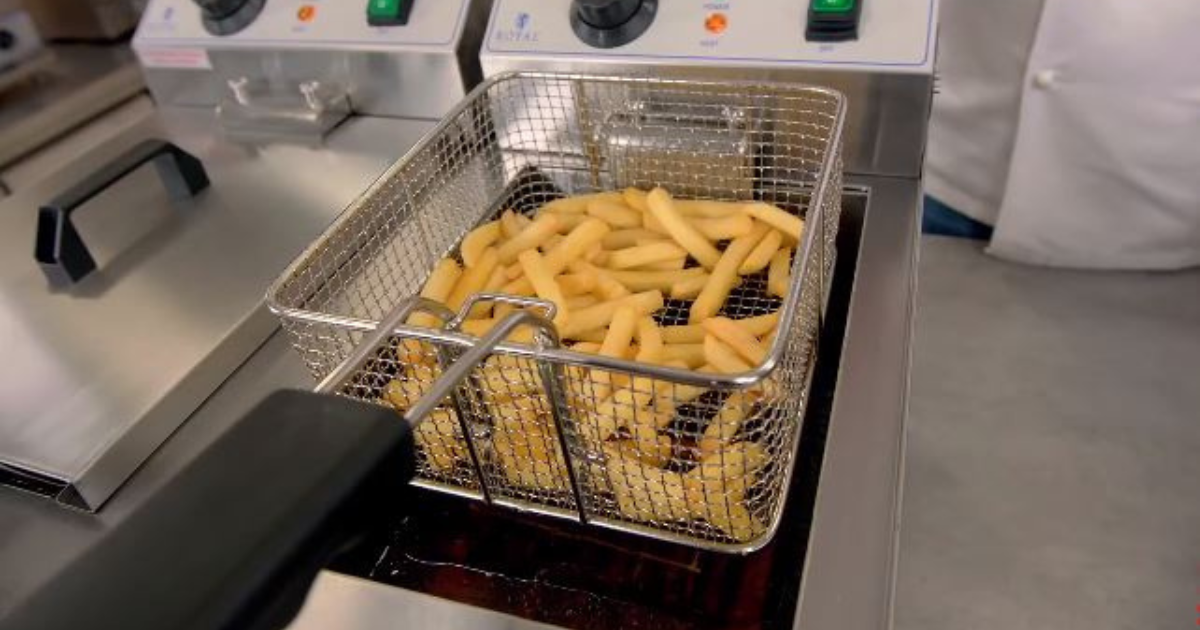Deep fryers are kitchen appliances designed for both home and commercial use, offering a quick and efficient method to prepare a variety of fried dishes. They operate by heating oil to a high temperature, usually between 350°F and 375°F, which cooks food thoroughly and quickly, resulting in a crisp exterior and moist interior.
Deep fryers cook food by submerging it in hot oil. They utilize a heating element to maintain the oil at a consistent temperature.

A thermostat controls the oil temperature, ensuring that it remains hot enough to cook food without reaching the smoke point where oil begins to break down. With safety features such as automatic shut-off and cool-to-touch exteriors, deep fryers provide a secure way to achieve perfect frying results. Compact designs and easy-to-clean components also make them a convenient addition to any kitchen. Whether you’re making french fries, chicken, or doughnuts, a deep fryer can help you achieve that desired golden brown perfection.
The Heat Is On: The Science Of Deep Frying
The Heat Is On: The Science of Deep Frying transforms your favorite snacks from raw to ravishing. It’s not just about dunking food in hot oil; it’s a delicious dance of temperature and time, ensuring that sumptuous golden-brown perfection. Let’s heat things up and explore the sizzling science behind the magic of deep frying.
Turning Up The Temperature: How Heat Transforms Food
Introducing food to a deep fryer kicks off a fascinating transformation. The high heat does several things:
- Cooks the food: Heat transfers from the oil to the food, cooking it from the outside in.
- Creates a crust: The surface dehydrates, and in combination with the oil, forms a crispy outer layer.
- Seals in flavor: The crust traps the food’s moisture and flavors inside.
The science is simple. Apply heat, and food changes texture, taste, and color, often improving vastly.
A Dive Into Oil: Properties For Perfect Frying
Not all oils are created equal when it comes to deep frying. Here are the must-haves for the perfect fry-up:
| Oil Property | Importance in Frying |
|---|---|
| Smoke Point | Higher smoke points prevent burning and unpleasant flavors. |
| Stability | Stable oils don’t break down at high temperatures, ensuring consistency. |
| Flavor | Neutral oils don’t overpower the food’s natural taste. |
Select the right oil and witness a crispy, golden transformation that’s nothing short of mouth-watering.
Types Of Deep Fryers: From Home To Commercial
Deep fryers create tasty foods by cooking them in hot oil. They come in different sizes and powers. Home cooks and chefs use them for crispy meals. Let’s explore the various types available for both home and commercial use.
Counter-top Warriors: Compact Deep Fryers
The perfect fit for small kitchens, compact deep fryers are easy to use and store. Homes and small restaurants often choose these models. Their features can vary:
- Adjustable Thermostats for the perfect temperature.
- Baskets for easy food handling.
- Safety Features to prevent accidents.
These deep fryers cook quick meals like fries and nuggets. They need less oil and space than big fryers. Many have cool exteriors to keep kitchens safe.
Industrial Powerhouses: The Professional Fryers
Professional deep fryers handle big jobs. They’re found in busy restaurants and food places. These fryers can cook lots of food quickly. Here’s what they offer:
| Feature | Benefit |
|---|---|
| Large Oil Capacity | Can cook more at once. |
| Powerful Heating Elements | Faster cooking times. |
| Durable Design | Handles heavy use. |
Professional fryers stand up to the rush of a busy kitchen. They have filters to keep oil clean and thermostats to control heat. Many are made of stainless steel for easy cleaning and long life.
The Fryer’s Heart: Understanding The Heating Element
Deep fryers work wonders in cooking crispy delights. The heart of any deep fryer is its heating element. This crucial part raises the oil’s temperature to the perfect frying point. Knowing how it operates is key to mastering the art of deep frying.
Electric Vs. Gas: Choosing Your Heating Source
Choosing the right heating source for your deep fryer significantly affects its performance. Let’s dive into the differences between the two popular types.
- Electric Fryers: These use electricity to heat the element which, in turn, heats the oil.
- Gas Fryers: These models rely on a gas flame, often requiring a connection to a propane or natural gas line.
Maintaining The Heat: Thermostat Roles
A consistent temperature is vital for perfect frying results. The thermostat in a deep fryer plays a pivotal role here. It ensures the oil stays at your set temperature.
| Function | Benefit |
|---|---|
| Monitors Oil Temperature | Gets consistent cooking results |
| Adjusts Heating Element | Keeps the fryer safe for use |
Oil’s Role In A Deep Fryer’s Life
Imagine diving into a pool where every inch of your body gets an even tan. That’s what oil does in a deep fryer. It surrounds your food, cooking it evenly and quickly. Oil acts not just as a heat transfer medium but also adds that unique crispiness and flavor we love in fried foods. The longevity and performance of a deep fryer greatly depend on the oil it uses.
Choosing The Right Oil: Smoke Points Matter
To pick the best oil for your deep fryer, consider the ‘smoke point’—the temperature oil starts to smoke and break down. Higher smoke point oils are essential for a good frying experience.
- Canola Oil: Affordable and versatile, with a smoke point around 400°F.
- Peanut Oil: Popular for frying with a smoke point of 450°F.
- Safflower Oil: High smoke point at 510°F, perfect for high-temp frying.
The Art Of Oil Maintenance: Cleaning And Replacing
Clean oil means tastier food. Strain out food particles daily to prevent them from burning, which can spoil the oil’s flavor and your food.
| Frequency | Action |
|---|---|
| After Each Use | Strain and store oil if it’s still good |
| Every 5-10 uses | Replace oil to maintain quality |
To track oil’s life, use a test strip to check fatty acid levels. Change the oil if the strip shows high levels. Remember, old oil can affect your deep fryer’s performance and food quality.
Safety Measures: Preventing Grease Fires And Burns
Welcome to the critical part of using deep fryers: ensuring safety. Grease fires and burns can turn a perfectly good cooking experience into a disaster. Understanding and implementing safety measures are vital. Let’s talk about how to stay safe while enjoying the delicious outcomes of deep frying.
Building A Safe Frying Haven: Equipment Safety Features
Deep fryers come with built-in safety features. These are essential to minimize risks. Here’s what to look for:
- Auto Shut-Off: A mechanism that turns the fryer off to prevent overheating.
- Cool-Touch Exterior: Surfaces that stay cool to avoid burns.
- Lid Covers: To prevent splatter and reduce the risk of grease fires.
- Breakaway Cords: These pull away easily to prevent the fryer from tipping over.
- Thermostats: For precise temperature control, reducing the chance of oil reaching its flashpoint.
Always choose a fryer with these features and check for any product recalls.
User Best Practices: Avoiding Kitchen Disasters
No deep fryer is foolproof without good practices. Follow these steps:
- Never leave the fryer unattended while it’s on.
- Keep the area clear of flammable materials and clean from oil spills.
- Avoid water near the fryer as it can cause oil to splatter and potentially start a fire.
- Use utensils with long handles to keep hands at a safe distance.
- If oil smokes, turn off the fryer immediately. This is a sign it’s too hot.
Equip your kitchen with a fire extinguisher rated for grease fires. Teach all users these practices for a safe cooking environment.
Taste And Texture: Culinary Magic Of Deep Fryers
The culinary magic of deep fryers transforms simple ingredients into irresistibly crispy delights. The taste and texture achieved through deep frying are unparalleled, as foods acquire a distinctive crunch and flavor that are both satisfying and addictive. Uncover the secrets behind the golden exterior and flavor-packed profiles made possible by the deep fryer.
The Crisp Factor:
Achieving The Golden Crunch
The key to crunch lies in the high temperatures of the oil used in deep fryers. High heat seals food quickly, creating a rapid water vaporization. This leaves behind a hard outer shell that we adore.
- Perfect Temperature: Usually between 350°F (175°C) and 375°F (190°C).
- Frying Time: Short but precise; depends on the food type.
- Batter/Breading: Adds extra texture and protects the food’s moisture.
The result is a uniformly golden and scrumptious exterior that’s music to your taste buds.
Flavor Infusion:
How Oil Enhances Taste
Oil serves as the flavor conductor in deep frying. It can impart subtle tastes and enrich the food’s natural flavors. Better oil quality equals better taste.
| Oil Type | Flavor Profile |
|---|---|
| Canola | Mild, suitable for all foods |
| Peanut | Nutty, perfect for chicken |
| Sesame | Strong, ideal for Asian dishes |
As the food fries, the oil penetrates its surface, locking in flavors and adding a juicy, succulent interior to the crisp exterior.
Environmental And Health Considerations
Understanding how deep fryers work goes beyond their kitchen magic. Environmental and health considerations play a pivotal role. We’ll explore the balance of enjoying crispy fried foods while being mindful of impacts on health and the planet.
Navigating Health Concerns: Balancing Fryer Use
Deep frying delivers delicious food, but it’s important to acknowledge its health implications. Let’s dive into how to enjoy fried foods responsibly:
- Use High-Quality Oil: Opt for oils with high smoke points. This reduces harmful compounds.
- Regulate Cooking Temperature: Keep the fryer’s temperature within safe limits. It prevents oil from breaking down.
- Minimize Usage: Enjoy deep-fried treats occasionally to maintain a balanced diet.
- Proper Ventilation: Ensure your frying area is well-ventilated. It minimizes inhalation of unhealthy vapors.
Eco-friendly Frying: Reducing Waste And Energy Consumption
Deep fryers can be eco-friendlier. Here’s how you can fry food whilst caring for the environment:
| Aspect | Eco-friendly Tips |
|---|---|
| Oil Disposal | Recycle used oil or dispose of it properly to prevent pollution. |
| Energy Efficiency | Choose energy-efficient fryers. Look for ENERGY STAR ratings. |
| Waste Reduction | Use reusable filters instead of disposable ones. |
| Biodegradable Products | Use eco-friendly cleaning products for your fryer maintenance. |
Frequently Asked Questions
How Does Deep Frying Work?
Deep frying cooks food by submerging it in hot oil, typically around 350°F to 375°F. The heat causes the food’s surface to crisp while cooking it fully inside through a heat conduction process.
What Is The Liquid In A Deep Fryer?
The liquid in a deep fryer is typically edible oil or fat used for cooking. Common oils include vegetable, canola, peanut, and sunflower.
How Do Commercial Deep Fryers Work?
Commercial deep fryers heat oil to high temperatures, typically using gas or electricity. Food is submerged in the oil, cooking quickly and evenly through direct contact with the hot liquid.
Why Do Deep Fryers Only Go To 375?
Deep fryers often cap at 375 degrees Fahrenheit to prevent oil from reaching its smoke point, ensuring food safety and optimal cooking conditions. This temperature balances efficient cooking with minimizing the risk of burning the oil.

